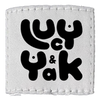The Rock Star of fibres!
Hemp is often thought of as a bit of a wonder fabric, but we have to get a little bit creative with how we use it. The main downside to hemp, which is made from the cannabis plant, is that it can be quite a course, rough fabric. In the past, we are thinking something not much different from a sackcloth and ashes (well, maybe just the sackcloth). There is an advantage even to this though, which is that it is really hard wearing, and over time it becomes softer. It becomes the kind of comfy, worn-in clothes that you want to wear all the time, that feel a bit like a second skin. But it needs a bit of help from other fibres to get you there.
Why it's so great
So what is it about hemp that's so great (apart from the look of the fabric which I think is just so appealing)? Hemp helps the environment in which it is grown, rather than damaging it. The hemp plant's roots can reach as far as 3 metres underground, holding the soil together whilst also building and preserving the quality of the soil. Hemp plants leave the soil enriched and improved rather than draining the nutrients out of it. It also grows really quickly so you can get a lot of fibre from one field. 250% more than if you were growing cotton in the same space.
And this is without pesticides. Hemp doesn't need the use of pesticides or herbicides. This is a huge advantage. The damage throughout ecosystems caused by pesticides is catastrophic but the hemp plant is so vigorous and robust that it grows in just 100 days, without the use of chemicals. It also grows in a pretty wide range of places, thriving in tropical zones and in temperate climates. This is why it has been given the nickname “weed”. It will grow of its own accord and doesn't need much help to do it.
In case you're wondering, the hemp plant is related to the marijuana plant – they are both types of cannabis (from which the word “canvas” is derived) but our hemp plant has only traces of the psychoactive chemicals that are found in it's well known relative. Not enough to have any medicinal or recreational implications.
The process
You may be wondering where the fibre is on the plant that is used to make the fabric. Hemp isn't like cotton which produces little clumps of fibre, sitting and waiting to be picked. Hemp fibre is produced from the stems of the plant. This isn't as unusual as it might sound; several fibres like linen and flax are produced in the same kind of way. Even the bamboo plant can be turned into fibre. In fact, hemp hasn't only been used to make fabric. It's also been used to make paper, rope and canvas.
To transform a hemp plant into fabric, the fibres in the stalk are separated from the bark. This is called “retting”. Then they are be spun to make thread, and woven into fabric. You could even knit with it. The process can be done chemically which significantly increases the environmental impact of the process, but it can also be done mechanically which is much more environmentally friendly. It is also important to think about how it is dyed; hemp doesn't hold dye all that well and the dyeing process can have a big environmental impact.
No plant makes the perfect fabric, but hemp is just about as close as you can get. And there are some pretty exciting developments in processing and using hemp to make beautiful, comfortable fabrics that we can wear for years and years.
Kunal our amazing fabric supplier in India is working hard to create a hemp/cotton blend for us to work with, this might take some months as we need to get the texture just right, but watch this space, hemp Lucy & Yaks coming soon, hopefully!
Also I found out that you can make corduroy with the stuff!! Woohoo!

